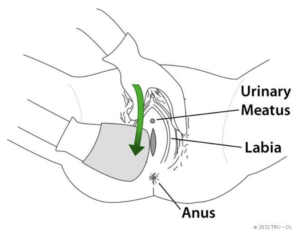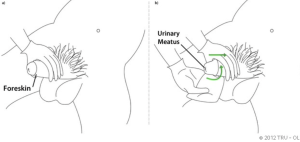4.4 Perineal Care
The perineum is the tiny patch of sensitive skin between the genitals (vaginal opening or scrotum) and anus, and it’s also the bottom region of the pelvic cavity. The perineum may refer to just the part of your body you can see (the skin in between your genitals and your anus). Some might refer the perineum as the perineal area, genital area, or the triangle area between the legs.
Perineal care (peri-care) is bathing the genitalia and surrounding area. Some clients may be embarrassed, but this is part of client care. It is important to maintain a professional, matter-of-fact attitude. As with all good caregiving efforts, remember to allow the client to do as much as they can on their own. You can start by providing the client with a wet washcloth, soap, and a towel and then instructing them to wash the perineal area. You may need to say it in simpler terms so they understand, such as, “I’ll give you a washcloth so you can wash between your legs or your private area.” Remind clients with uncircumcised penises to retract the foreskin to cleanse the penis.
Cleanliness of the genital area is an important part of everyone’s care, particularly if the client is having difficulty controlling bowel and bladder function. This procedure is part of personal hygiene care and must be done whenever the client is soiled or wet.
Perineal Care for a Client with a Vulva
This procedure should always be a part of A.M. care.
| STEP | ACTION | REASON |
|---|---|---|
| 1. | With the client lying on their back, uncover the perineal area only. | Provides privacy and warmth. |
| 2. | Put on gloves. | Medical asepsis to avoid contact with mucous membranes. |
| 3. |
|
 Asepsis: Wash from top to bottom and clean to dirty to prevent cross-contamination. |
| 4. |
|
|
| 5. |
|
|
| 6. | Turn the client on their side facing away from you. | |
| 7. | Wash and rinse buttocks. | |
| 8. |
|
Asepsis. Do not rinse or place the washcloth in the basin after washing the anal area. |
| 9. | Dry buttocks then dry anus. | |
| 10. | Remove gloves. | |
| 11. | Wash hands or use hand sanitizer. |
Perineal Care for a Client with a Penis
This procedure should always be a part of A.M. care.
| STEP | ACTION | REASON |
|---|---|---|
| 1. | With the client lying on their back, uncover the perineal area only. | Provides privacy and warmth |
| 2. | Put on gloves. | Medical asepsis to avoid contact with mucous membranes. |
| 3. |
|
 Principles of asepsis: wash from near to far and top to bottom to prevent cross-contamination. |
| 4. | Wash shaft of penis from head of penis toward the body, using a clean part of the cloth for each stroke. | To prevent cross-contamination. |
| 5. | Wash down the upper surface of the scrotum. | |
| 6. |
|
Principles of asepsis: wash from near to far and top to bottom to prevent cross-contamination. |
| 7. | Turn the client on their side facing away from you. | |
| 8. | Wash and rinse the buttocks. | |
| 9. |
|
Asepsis. Do not rinse or place the washcloth in the basin after washing the anal area. |
| 10. | Dry buttocks, then dry the anus. | |
| 11. | Remove gloves. | |
| 12. | Wash hands/use hand sanitizer. |
Additional Notes and Adaptations for Perineal Care
If the client is very difficult to turn or finds it painful to turn, you can use an adaptation to personal hygiene care and perineal care.
After washing the face, axilla, and hands, you may then wash the perineal area. You then remove your gloves, change the wash water, and obtain a new washcloth and towel. Then position the client on their side (Sim’s position), wash their back, and then put on new gloves and wash the anal area. By doing hygiene care in this sequence, you reduce the number of times you must turn the client, but you are still following all the principles of asepsis.
If the client wears an incontinent brief, you can then put that on while the client is on their side. Fanfold one side of the brief and tuck it under the client. Check for correct placement of the brief. It should cover their buttocks and groin area. The top part of the brief will be about 2.5–7.5 cm (1–3 inches) above their buttocks. Roll the client to the other side. Let them know they will feel a “bump” from the brief as they roll over it. Ensure the bed rails are up. Move to the other side of the bed. Pull the other half of the brief from under the client. Assist the client back to the supine position (client is lying on their back). Pull the brief up between their legs. Peel tape from tabs and fold each side inward toward the front. Secure tape to the front of the brief.
The “Personal Care – Health Care” video playlist demonstrates the techniques for Personal Hygiene Care.
From the Personal Care – Health Care Playlist videos, watch Chapters 8–10. These videos are from BCcampus, written and produced by Chantal Lortie and Natasha Fontaine (2022), from Selkirk College and COTR, and licensed under a CC BY-NC 4.0 licence.
The tiny area of sensitive skin between the genitals (vaginal opening or scrotum) and anus, and it’s also the bottom region of the pelvic cavity. Sometimes referred to as the peri-area.
Washing or bathing the genitalia and surrounding area. Peri-care is commonly used as a shortened form of perineal care.
The opening at the end of the urethra through which urine (and semen in people with penises) is excreted from the body.
The outer skin (or flaps of skin) around the vaginal opening. The labia majora on the outside tends to be larger and plump, covered with pubic hair. The labia minora are the inner set next to the labia majora.
The procedures to reduce the number of microorganisms and prevent their spread. Also known as clean technique.

